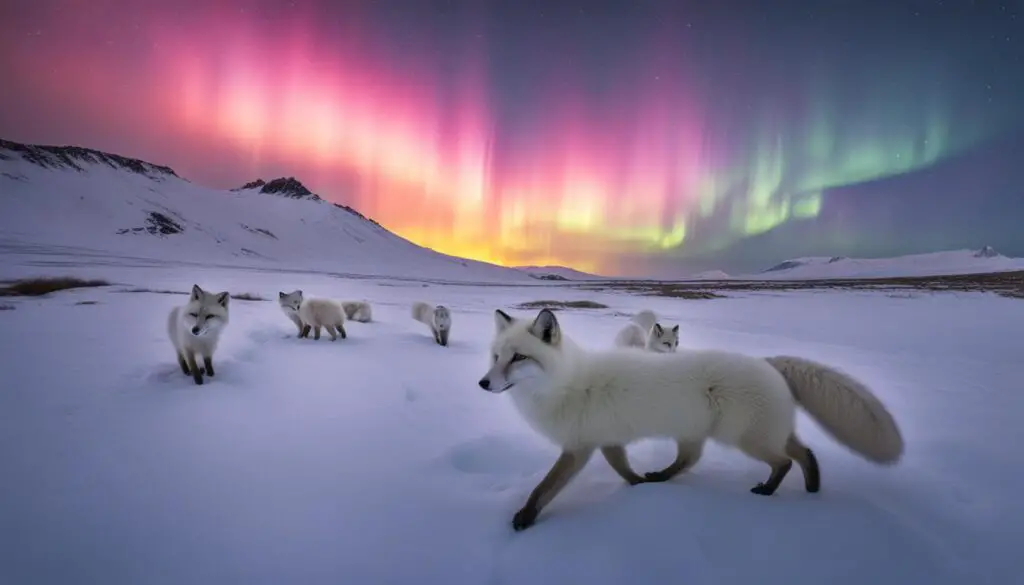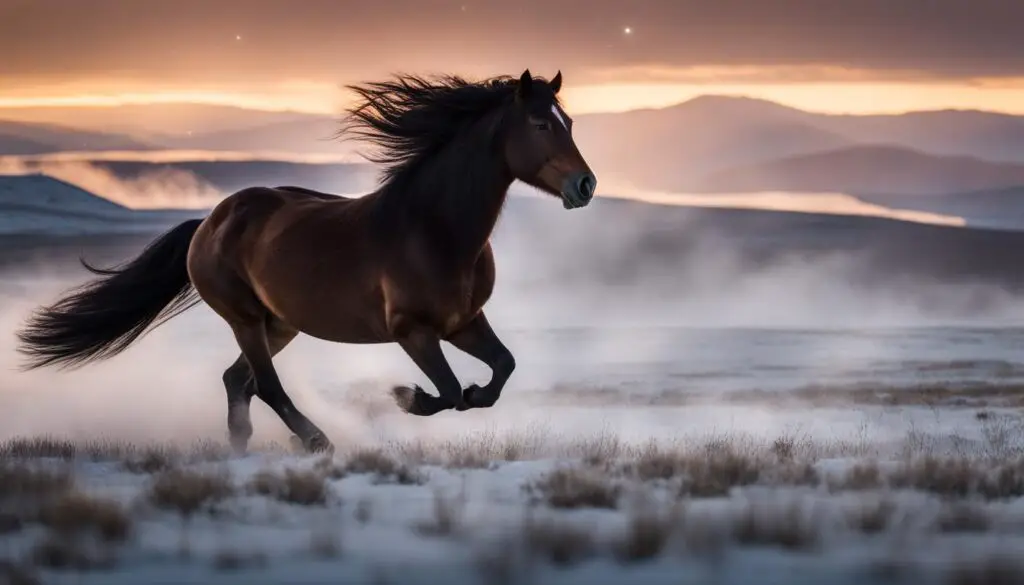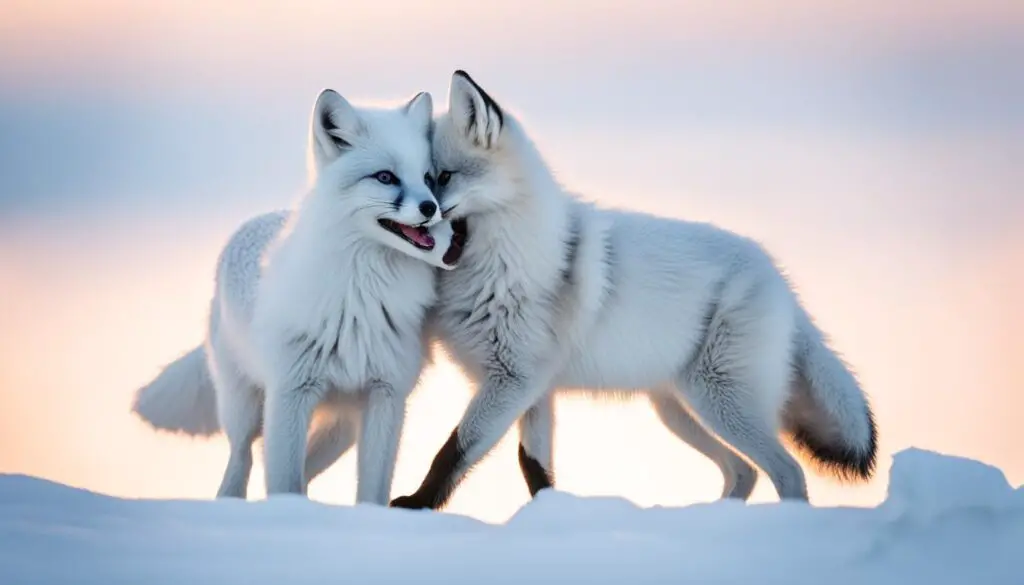Iceland is a country known for its breathtaking landscapes and unique wildlife. From the icy waters of the North Atlantic to the rugged terrain of its volcanic landscapes, Iceland is home to a diverse range of animals. Whether you’re interested in Icelandic wildlife, Arctic animals in Iceland, or the endangered species that inhabit this remote island, there is something for everyone to discover in the world of Icelandic animals.
When it comes to mammals in Iceland, one of the most iconic species is the Arctic fox. This native land mammal has adapted to the harsh climate of Iceland and can be found in various regions of the country. In addition to the Arctic fox, you may also spot Icelandic horses, known for their strength and unique appearance. These resilient animals have been an integral part of Icelandic culture for centuries.
The bird lovers among us will be delighted to know that Iceland is a paradise for avian enthusiasts. The country boasts a diverse bird population, with species such as puffins, gannets, and guillemots gracing the coastal cliffs. Observing these majestic birds in their natural habitat is an unforgettable experience.
Marine life in Iceland is equally impressive. The surrounding waters are teeming with various species of whales, including humpback whales, orcas, and blue whales. If you’re fortunate, you may even spot seals lounging along the coastlines or in the icy waters of the Jökulsárlón glacier lagoon.
While exploring the animals in Iceland, it’s essential to remember the need for conservation efforts. Some species, such as the Arctic fox, are considered endangered, and their protection is crucial for maintaining the delicate balance of Iceland’s ecosystems.

Key Takeaways:
- Iceland is home to a diverse range of animals, including Arctic foxes, Icelandic horses, and various bird species.
- The country’s marine life includes whales and seals, providing ample opportunities for whale watching and seal spotting.
- Conservation efforts are necessary to protect endangered species like the Arctic fox and maintain the fragile ecosystems of Iceland.
- Exploring the animals in Iceland offers a unique and unforgettable experience for wildlife enthusiasts.
Domestic Animals in Iceland
The majority of the animals found in Iceland are domestic animals that play a vital role in the country’s agriculture. These include Icelandic sheep, Icelandic sheepdogs, Icelandic horses, and cattle. These animals have adapted to the harsh climate of Iceland and have been essential for human survival throughout history.
Non-Native Wildlife in Iceland
While Iceland is renowned for its native wildlife, it is also home to several non-native species that have been introduced to the island. These non-native populations have successfully established themselves in various regions of Iceland, bringing a unique element to the country’s diverse ecosystem.
One notable non-native species found in Iceland is the reindeer. Although not indigenous to the island, reindeer can be spotted in the eastern part of Iceland, particularly in the areas of East Fjords and Vatnajökull National Park. The presence of reindeer in East Iceland adds a touch of wilderness and diversity to the already stunning landscapes.
In addition to reindeer, Iceland is also home to non-native rodents and mink. These small mammals have been introduced to the island and have managed to thrive in their new environment. While they may seem harmless, the influx of these non-native species can have an impact on the native ecosystem.
Efforts are being made to mitigate the impact of non-native wildlife on Iceland’s native flora and fauna. Various measures, such as monitoring and control programs, are in place to manage the populations of these non-native species and prevent any detrimental effects on the delicate balance of Iceland’s ecosystem.
Non-Native Wildlife in Iceland:
| Species | Location | Status |
|---|---|---|
| Reindeer | East Iceland (East Fjords and Vatnajökull National Park) | Established |
| Rodents | Throughout Iceland | Established |
| Mink | Throughout Iceland | Established |
Although the presence of non-native wildlife in Iceland brings its own set of challenges, it also provides an opportunity for research and understanding of how these species interact with the native environment. Through careful management and conservation efforts, Iceland aims to preserve the delicate balance of its unique and diverse ecosystem.
Native Wildlife in Iceland
Iceland is known for its diverse and captivating native wildlife. From the unique Arctic foxes to the majestic whales, there is an abundance of fascinating animal species to discover in the country. Let’s take a closer look at some of the iconic native wildlife in Iceland:
Arctic Foxes of Iceland
The Arctic fox, also known as the Icelandic fox, is the only native land mammal in Iceland. These beautiful creatures have adapted to the harsh Arctic climate and are well-suited to survive in the extreme conditions of the island. With their thick fur and the ability to change the color of their coat, they can blend perfectly into their snowy surroundings. The Arctic foxes in Iceland are truly a sight to behold.
Whales of Iceland
The surrounding waters of Iceland are home to a wide variety of whale species, making it a popular destination for whale watching. From majestic humpback whales to graceful minke whales, visitors have the opportunity to witness these magnificent creatures up close. Whale watching tours in Iceland offer a truly unforgettable experience, allowing you to observe these gentle giants in their natural habitat.
Seals of Iceland
Iceland’s coastlines and the icy waters of the Jökulsárlón glacier lagoon are inhabited by various species of seals. These adorable marine mammals can often be seen basking on the shores or playfully swimming in the waters. Watching the seals in their natural environment is a delightful experience for nature enthusiasts visiting Iceland.
Puffins of Iceland
One of the most beloved and iconic birds in Iceland is the puffin. These comical seabirds nest in Iceland during the spring and summer months, making up a significant portion of the global puffin population. Their colorful beaks and unique appearance make them a favorite subject for photographers and birdwatchers. Seeing a puffin up close is a truly remarkable experience.
Other Birds of Iceland
In addition to puffins, Iceland is home to a wide variety of bird species. From gannets and guillemots to gulls and other migratory birds, the country provides ample opportunities for birdwatching. The diverse landscape of Iceland offers different habitats for birds to thrive and makes it a haven for bird enthusiasts.
Polar Bears from Greenland
Although not native to Iceland, polar bears occasionally visit the island from Greenland. These magnificent creatures are known for their resilience in the Arctic environment. While rare, the sightings of polar bears in Iceland attract considerable attention and awe from locals and tourists alike.

Exploring the native wildlife in Iceland is a captivating adventure. Whether you’re marveling at the Arctic foxes, witnessing the majestic whales, observing playful seals, or admiring the charming puffins, the wildlife of Iceland offers awe-inspiring encounters with nature.
Arctic Foxes of Iceland
Arctic foxes, also known as Icelandic foxes, are the only native land mammal in Iceland. These resilient creatures have adapted to the harsh Arctic climate and have become an integral part of Iceland’s unique wildlife.
Adaptation to Harsh Climate: Arctic foxes have evolved several adaptations that allow them to thrive in the extreme conditions of Iceland. Their most notable feature is their thick fur, which provides insulation and protection from the cold. During winter, their fur turns white to blend in with the snowy landscape, while in summer it changes to a brown or grayish color to match the earthy terrain.
The Arctic fox’s ability to change its fur color is a remarkable example of nature’s adaptability. It allows these foxes to camouflage themselves and remain hidden from predators or prey in their environment.
Arctic foxes are also incredibly resourceful when it comes to finding food. They have a varied diet that includes small mammals, birds, eggs, carrion, and even plant matter. Their ability to scavenge and withstand long periods without food makes them well-suited to the challenging conditions of their habitat.
Fox Conservation in Iceland: These iconic animals play a crucial role in Iceland’s ecosystem, and efforts are underway to protect and conserve their population. Conservation organizations in Iceland work towards preserving the natural habitats of Arctic foxes, raising awareness about their importance, and conducting research to better understand their behavior and needs.
“Arctic fox conservation efforts in Iceland are vital for maintaining the balance of the island’s delicate ecosystem and safeguarding this unique species for future generations,” says Dr. Ólafur R. Vilhjálmsson, a wildlife biologist and leading expert on Arctic foxes in Iceland.
Arctic Foxes at a Glance
| Scientific Name | Vulpes lagopus |
|---|---|
| Native to | Iceland and other Arctic regions |
| Status | Least Concern (IUCN Red List) |
| Physical Characteristics |
|
| Habitat | Tundra, grasslands, coastal areas |
| Diet | Small mammals, birds, eggs, carrion, plant matter |

Marine Life in Iceland
The waters surrounding Iceland are teeming with a diverse array of marine life, making it a haven for wildlife enthusiasts and nature lovers alike. Among the fascinating creatures that call these icy waters home are magnificent whales and playful seals.
Whales of Iceland
Whale watching has become a popular activity in Iceland, offering visitors a unique opportunity to witness these majestic creatures up close. The coastal areas of Iceland provide a perfect vantage point for spotting various whale species, including the impressive humpback whales, graceful minke whales, and even the elusive blue whales, the largest animals on Earth.
“Whale watching in Iceland is an awe-inspiring experience that allows you to witness the beauty and grandeur of these magnificent marine mammals. It’s a truly unforgettable adventure,” says marine biologist Dr. Anna Peterson.
Whether you embark on a guided whale-watching tour or observe from the shoreline, the chance to see these gentle giants in their natural habitat is an incredible sight to behold.
Seals of Iceland
As you explore the picturesque coastlines of Iceland, keep an eye out for the adorable seals that inhabit the icy waters. With their inquisitive nature, seals often emerge from the depths to bask on the rocky shores or playfully swim alongside passing boats.
The Jökulsárlón glacier lagoon, located in southeastern Iceland, is a particularly popular spot for seal sightings. This breathtaking glacial lake offers a serene environment where seals can be observed gracefully gliding through the crystal-clear waters, creating an enchanting spectacle.
Dr. Kristin Magnusdottir, a marine ecologist, explains, “Seals are an integral part of Iceland’s marine ecosystem. Their presence is not only a delight for visitors but also highlights the importance of preserving the delicate balance of our coastal waters.”
Whale and Seal Species in Iceland
| Whale Species | Seal Species |
|---|---|
| Humpback whale | Harbor seal |
| Minke whale | Grey seal |
| Blue whale | Hooded seal |
| Orca (killer whale) | Ringed seal |
Whether you’re captivated by the gentle giants of the sea or enchanted by the playful seals, exploring the marine life in Iceland promises a truly unforgettable experience. Seek out these incredible creatures during your visit and embrace the beauty of Iceland’s rich natural heritage.
Birds in Iceland
Iceland is renowned for its diverse bird population, attracting bird enthusiasts from around the world. Among the most iconic birds in Iceland are the puffins, which make up a significant portion of the global puffin population.
These colorful seabirds nest in Iceland during the spring and summer, creating a mesmerizing sight along the coastal cliffs. With their unique appearance and charming behavior, puffins are a favorite subject for photographers and nature lovers alike.
However, Iceland is also home to other captivating bird species. Gannets, with their impressive wingspan and distinct appearance, can be found on the coastal cliffs, diving into the sea to catch fish. Guillemots, with their black and white plumage, nest in large colonies along the rocky shores.
Gulls, both the common and lesser black-backed species, can be spotted throughout Iceland, especially near bodies of water. These versatile birds are known for their adaptability and can be found in various habitats, from urban areas to remote coastal regions.
For birdwatching enthusiasts, Iceland offers a wealth of opportunities to observe and appreciate these magnificent creatures. From puffins to gannets, the bird population in Iceland is a sight to behold.
Conclusion
Iceland is a haven for animal lovers, offering a unique and diverse range of wildlife. From the domestic animals that have played a crucial role in the country’s agrarian history to the native and non-native species that have adapted to the demanding conditions, the animals in Iceland contribute to the nation’s distinct identity.
Whether you’re lucky enough to spot an elusive Arctic fox, witness the awe-inspiring presence of majestic whales in the surrounding waters, or delight in the comical antics of the charming puffins, exploring the rich array of animals in Iceland is an experience that will stay with you forever.
Immerse yourself in the wonders of Icelandic wildlife and gain a deep appreciation for the resilience and adaptability of these remarkable creatures. Discover the Icelandic sheep, sheepdogs, horses, and cattle that have thrived in the challenging climate for centuries. Marvel at the biodiversity of native wildlife, including Arctic foxes, diverse bird species, and the captivating marine life that graces Iceland’s shores.
Whether you’re a nature enthusiast, an adventure seeker, or a wildlife photographer, Iceland’s animals offer captivating encounters and unforgettable memories. Visit Iceland and witness the splendor of its animals, further enriching your understanding of this remarkable country and its natural wonders.
FAQ
What animals can be found in Iceland?
Iceland is home to a diverse range of domestic and native wildlife, including Icelandic sheep, Icelandic sheepdogs, Icelandic horses, cattle, Arctic foxes, whales, seals, puffins, and various bird species.
Are there any non-native animals in Iceland?
Yes, there are non-native animals in Iceland, such as reindeer in East Iceland and introduced rodents and mink throughout the country.
What is the only native land mammal in Iceland?
The only native land mammal in Iceland is the Arctic fox.
What marine life can be found in Icelandic waters?
Icelandic waters are home to various species of whales and seals.
What is the significance of puffins in Iceland?
Puffins are an iconic bird species in Iceland, with a significant portion of the global puffin population nesting in the country during the spring and summer.
Are there any endangered species in Iceland?
While some species in Iceland may be threatened, there are currently no officially recognized endangered species in the country.
Can polar bears be found in Iceland?
Although polar bears are not native to Iceland, they occasionally visit the island from Greenland.
